22 April 2022
How to Find and Visit War Graves in Aotearoa New Zealand
Kia ora and hello! Did you know that in Aotearoa New Zealand the Commonwealth War Graves Commission (CWGC) commemorates 3,500 men and women of the Commonwealth forces who died during the First and Second World Wars?
In this handy guide, Becky Masters-Ramsay, Pou Tohu Matua Senior Advisor War Graves and National Memorials at Manatū Taonga Ministry for Culture and Heritage in New Zealand explains how to find and then visit Commonwealth war graves in New Zealand. Manatū Taonga is the agent for CWGC and cares for Commonwealth war graves in New Zealand and across Te Moana-nui-a-Kiwa (the Pacific Ocean).
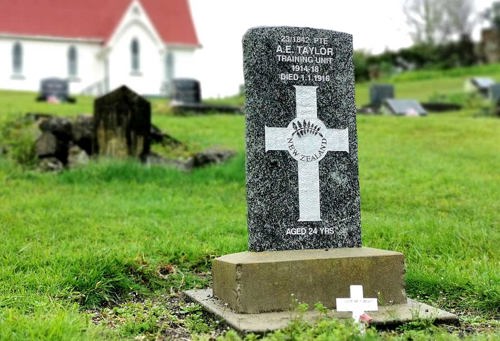
The grave of Private Arthur Edward Taylor, whose final resting place is Whakapirau Church Cemetery, New Zealand, photograph by Becky Masters-Ramsay, courtesy of Manatū Taonga
New Zealand war history
Despite New Zealand’s distance from Europe and its relatively small population, the men and women of New Zealand played an important role in both world wars.
New Zealand First World War history
When Great Britain declared war on Germany in 1914, New Zealand was brought into the conflict as part of the British Empire. Despite its geographic isolation and small population, it immediately pledged support for the British cause. Many Māori iwi (tribes) answered the call, offering themselves for immediate service. The offer was accepted by the British government, and 2,500 Māori served overseas, from a total Māori population of only 63,000.
As early as October 1914, the New Zealand Expeditionary Force (NZEF) sailed from Wellington. Diverted from their original destination in Europe, the New Zealanders landed in Egypt where they helped defend the Suez Canal in February 1915.
On 25 April 1915, as part of the New Zealand and Australian Division, New Zealanders landed at Anzac Cove, Gallipoli. They played a key role throughout the campaign until the evacuation from the peninsula at the end of the year. Following reorganisation of New Zealand forces, the New Zealand Mounted Brigade remained in Egypt and took part in the campaign in Sinai and Palestine. The newly formed New Zealand Division was sent to the Western Front.
The New Zealand Division fought at Longueval on the Somme on 15 September as part of a major British Army offensive. By the time they were relieved on 4 October, the New Zealanders had advanced three kilometres and suffered more than 7,000 casualties.
In June 1917, the New Zealand Division helped to capture Messines Ridge but in October its involvement in the Third Battle of Ypres led to heavy losses. On 12 October, attacking near Passchendaele, New Zealanders lost 850 men. It remains the worst disaster in New Zealand’s history in terms of lives lost in a single day.
New Zealanders continued to fight on the Western Front throughout 1918. On 4 November, they captured the ancient fortress town of Le Quesnoy in a daring assault only a few days before the Armistice.
More than 100,000 New Zealand troops and nurses served overseas during the war, not including those serving in British and other Dominion forces. This was around 10 percent of a population of just under a million and an estimated 42 percent of men of military age served in the NZEF. New Zealanders served at sea and in the air and a Maori contingent participated in the Gallipoli campaign before serving on the Western Front as part of the Maori Pioneer Battalion.
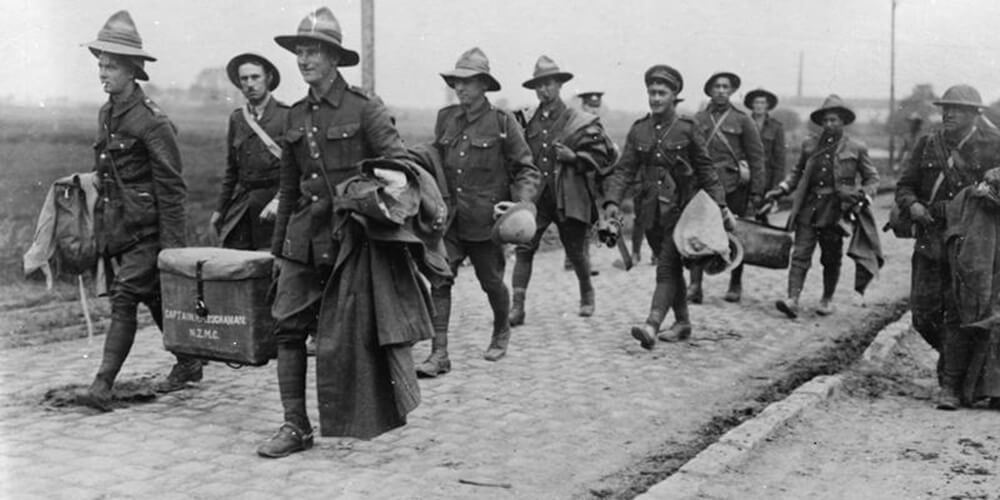
Troops of the New Zealand Pioneer Battalion moving to their quarters, © IWM Q 653
New Zealand Second World War history
At the outbreak of war in 1939, New Zealand formed the 2nd New Zealand Expeditionary Force. Almost immediately, the New Zealand government agreed to establish an all-Māori unit, the 28th (Māori) Battalion, which took part throughout the campaigns in the Middle East, North Africa and the Mediterranean. Māori also served in all of the other infantry battalions as well as throughout the other services.
The first of several contingents of troops sent overseas arrived in Egypt in February 1940. After the German invasion of Greece in April 1941, New Zealand troops fought a series of rear-guard actions as British-led forces retreated to the south. They were evacuated to Crete, where the Germans began an airborne attack in May. After six days of heavy fighting, most were evacuated back to Egypt, but many remained and were taken prisoner.
New Zealanders fought in North Africa from 1941 to 1943, including the Battle of El Alamein. After moving to Italy in October 1943, they were engaged there almost continuously until the end of the war in 1945 including the fierce Battle of Monte Cassino in Italy.
In the Pacific, New Zealand forces provided garrisons for Fiji and Fanning Island and later for Tonga, Norfolk Island and New Caledonia. They carried out operations to capture Lavella, Treasury Island and the Green Islands.
The New Zealand Division of the Royal Navy played an active role throughout the war. The cruiser HMS Achilles fought at the Battle of the River Plate in December 1939. Both Achilles and her sister ship HMS Leander undertook many escort and patrol duties across the Indian Ocean and Pacific, including protecting convoys between the US and South Pacific.
Around 7,000 New Zealanders served in the Royal Navy during the war seeing action from the Arctic to Cape Horn and from Iceland to Japan.
Some 500 New Zealanders were serving in the Royal Air Force in September 1939 and a further 11,000 were attached to the Royal Air Force during the course of the war, serving in every important operation and theatre. Royal New Zealand Air Force squadrons also served in the Pacific war from its outset.
New Zealand war dead
The CWGC commemorates more than 18,000 people who died while serving with New Zealand forces between 1914 and 1921, and more than 11,900 people who died while serving with New Zealand forces in World War Two.
Some of the most notable cemeteries and memorials that commemorate the men and women of New Zealand are:
World War One cemeteries and memorials
Chunuk Bair Cemetery, Turkey, is the final resting place of some 630 servicemen of the British Empire, only 10 of whom lay in named graves, the rest are unknown. Within the cemetery stands the Chunuk Bair New Zealand Memorial which commemorates some 850 New Zealand servicemen who have no known grave, many of whom are belived to be buried in the cemetery.
Buttes New British Cemetery, Belgium, is the final resting place of more than 2,100 servicemen of the British Empire including more than 160 New Zealand servicemen. Within the cemetery stands the Buttes New British Cemetery New Zealand Memorial which commemorates nearly 380 New Zealand servicemen who have no known grave.
Caterpillar Valley Cemetery, France, is the final resting place of some 5,570 servicemen of the British Empire including more than 210 New Zealand servicemen. Within the cemetery stands the Caterpillar Valley New Zealand Memorial which commemorates more than 1,200 New Zealand servicemen who have no known grave.
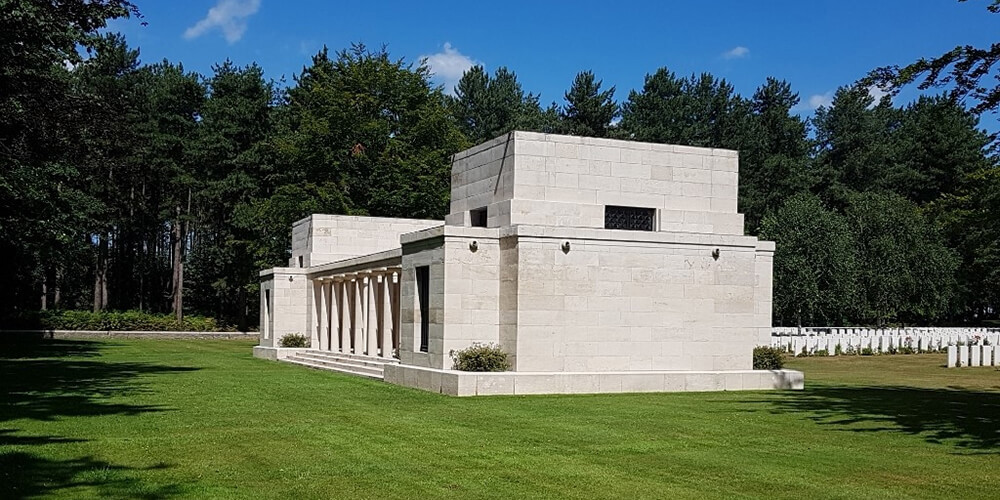
Buttes New British Cemetery New Zealand Memorial
World War Two cemeteries and memorials
El Alamein War Cemetery, Egypt, is the final resting place of some 7,240 Second World War Commonwealth servicemen including more than 1,100 New Zealand servicemen. At one end of the cemetery stands the Alamein Memorial which commemorates some 11,860 Second World War Commonwealth servicemen, including nearly 860 of New Zealand, who died in the North African campaign and have no known grave.
Phaleron War Cemetery, Greece, is the final resting place of some 2,030 Second World War Commonwealth servicemen including more than 250 New Zealand servicemen. Within the cemetery stands the Athens Memorial which bears the names of some 2,870 Second World War Commonwealth servicemen, including nearly 480 of New Zealand, who have no known grave. On the island of Crete is Suda Bay Cemetery where some 1,500 Second World War Commonwealth servicemen, including nearly 450 of New Zealand, are commemorated.
Bourail New Zealand War Cemetery, New Caledonia, is the final resting place of nearly 250 Second World War Commonwealth servicemen of which the majority, nearly 240 are of New Zealand forces. Within the cemetery is the Bourail Memorial which commemorates nearly 450 Second World War Commonwealth servicemen, including more than 300 of New Zealand who died during the fighting in the South Pacific and have no known grave.
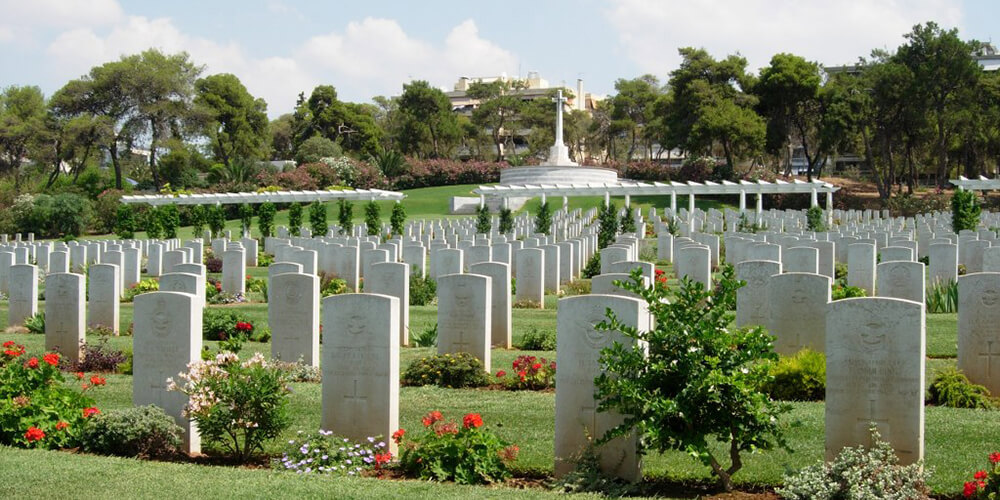
Phaleron War Cemetery, Greece
WHERE ARE THE WAR GRAVES IN AOTEAROA NEw Zealand?
There are New Zealand war dead from both world wars commemorated in almost all theatres of the war, from the United Kingdom, the battlefields of the Western Front, Gallipoli and the Pacific theatre. But despite seeing action around the world, there are many from the New Zealand forces who died in their home country.
How many war memorials are there in New Zealand?
There are a total of 442 sites throughout New Zealand where World War casualties are commemorated. Most of the sites are in local authority-run cemeteries, churchyards or urupā (Māori burial grounds). Most of the casualties buried in New Zealand died while on garrison or training duties, or in hospitals.
In New Zealand, there are also 570 casualties of both World Wars with no known grave who are commemorated on the New Zealand Naval Memorial in Devonport and on provincial NZ war memorials in Tāmaki Makaurau Auckland, Ōtautahi Christchurch, Ōtepoti Dunedin and Te Whanganui-a-Tara Wellington.
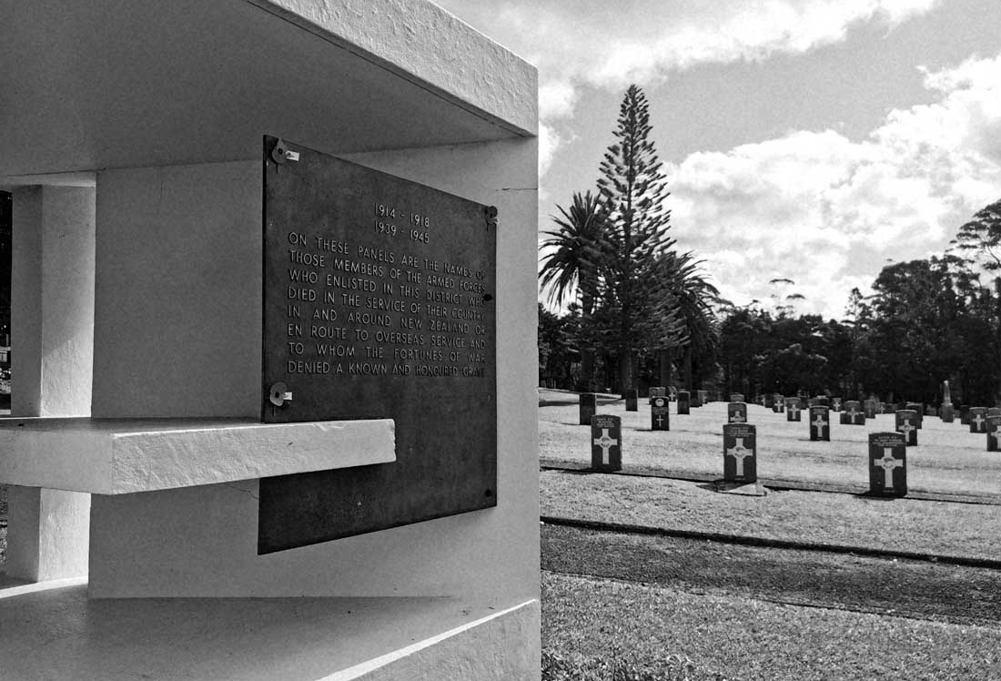
Tāmaki Makaurau Auckland Provincial Memorial, photograph by Becky Masters-Ramsay, courtesy of Manatū Taonga.
How to Find Commonwealth War Graves, New Zealand
You can easily discover the final resting places of World War casualties cared for by Manatū Taonga on the CWGC website. Using the dropdown ‘Visit Us’ menu on the homepage, select ‘Find War Memorials and War Cemeteries’.
You can find a list of all New Zealand sites (by selecting ‘New Zealand’ from the ‘Country’ list), and you can refine further to your place of interest by using ‘Locality’. If you are in New Zealand and want to know what could be nearby, you can also use your current location by selecting ‘Use my current locations’ to see a list of all New Zealand war cemeteries and memorials near you.
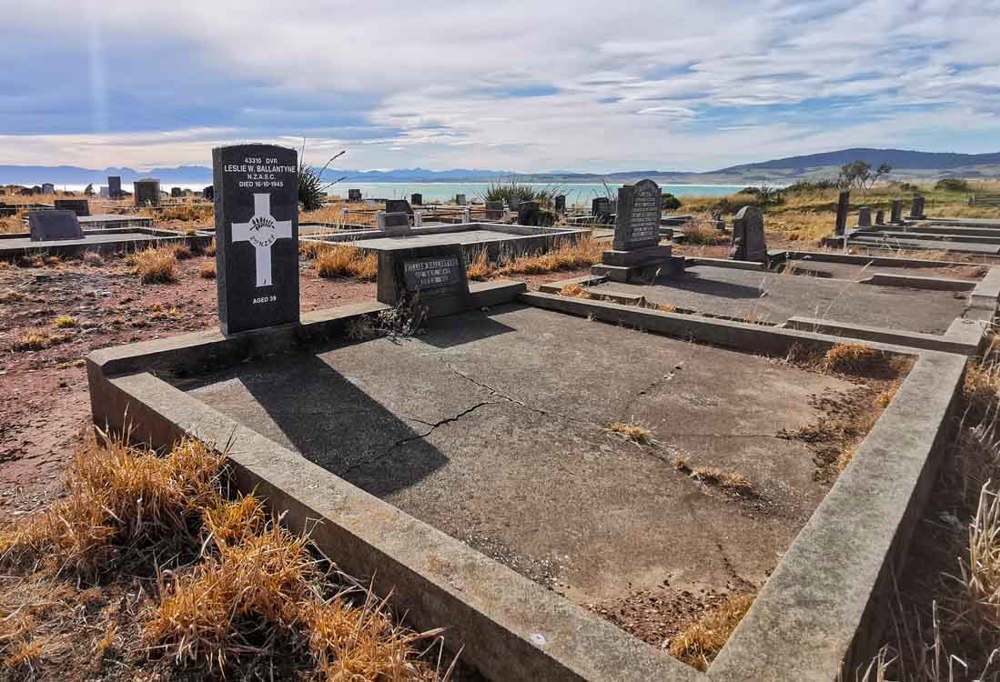
The grave of Driver Leslie William Ballantyne, whose final resting place is Orepuki Cemetery, New Zealand, photograph by Becky Masters-Ramsay, courtesy of Manatū Taonga.
WW1 New Zealand War Graves
Many of the World War One war dead buried in New Zealand are small numbers of burials in cemeteries and burial grounds across the country. There are some cemeteries that contain larger numbers, often at sites that were close to training grounds or hospitals.
Wellington Karori Cemetery is the second largest cemetery in New Zealand and contains Commonwealth burials from both wars alongside civilian burials. Nearly 269 burials of World War One, the majority of whom are from New Zealand, and a further 124 burials of World War Two. Within the cemetery is the Wellington Provincial Memorial which commemorates a further 84 war dead from both wars who have no known grave.
Close to 200 Commonwealth war dead are buried at Featherston Cemetery in the South Wairarapa District of New Zealand. Many of the deaths here were of service personel who were based at a nearby training camp. Many of the deaths occurred in 1918, as a result of the influenza pandemic.
WW2 New Zealand War Graves
Like the World War One burials, many of the World War Two war dead in New Zealand are buried in smaller plots and cemeteries across the country. Many of the larger concentrations of burials are in cemeteries that mix casualties of both wars.
The New Zealand Naval Memorial, Devonport, Auckland commemorates 352 naval personnel from World War Two who died across the world and have no known grave. Many of those commemorated here were lost at sea, with more than half lost in the sinking of the HMS Neptune. Many of the rest died as prisoners of war in the Pacific theatre.
Auckland Waikumete Cemetery contains 110 Commonwealth burials of World War One and 176 of World War Two here.The burials here are mixed service with war dead from air, land and sea all commemorated here. The cemetery also includes the Auckland Provincial Memorial, which commemorates 40 World War One casualties and 16 World War Two casualties, and the Auckland Waikumete Crematorium memorial, which commemorates 44 Second World War casualties.
FINDING CWGC WAR GRAVES ON THE GO
Even if you’re not an advance planner, that doesn’t mean you have to miss out on visiting a CWGC war cemetery or memorial while you’re in New Zealand. You can easily download the CWGC mobile app, available on the App Store and Google Play Store. It’s a great travel companion when exploring Aotearoa New Zealand. You can quickly search for cemeteries by name or location information, or use your phone’s location to find sites nearby.

WHICH NEW ZEALAND CEMeTERY HAS THE MOST COMMONWEALTH WAR GRAVES?
New Zealand’s Wellington (Karori) Cemetery, has the most Commonwealth War Graves. Located in the north-western part of Wellington, this cemetery holds 393 casualties of the two world wars. Many of those commemorated here died while receiving medical treatment in local hospitals.
One example is Lieutenant-Colonel John Edward Anderson, who died in 1945. Having served in both wars, Anderson is one of the most highly decorated service people in Karori Cemetery. He was awarded the Croix de Guerre with Palm, the Military Cross and Bar and, in 1942, was made an Officer of the Order of the British Empire for his vital role in the construction of the Western Desert railway.
Anderson became ill when serving in Burma with the Royal Engineers and was sent first to Perth Military Hospital and then to Wellington, where he died in hospital on 5 November 1945.
How Do I Find Out Where Someone is Buried in New Zealand?
Before you make the journey to visit a particular grave, you may want to do some research about the buried casualty. By searching using the ‘find war dead’ function on the CWGC website, you can find out about the records we maintain and the casualties commemorated at the site you’re visiting.
You can adjust your search by adding additional information, such as regiment or place of commemoration, or even whether the person you’re looking for served New Zealand during World War One or World War Two.
To make your search even easier, an exact match isn’t required. You’ll be presented with a list of all possible matches.
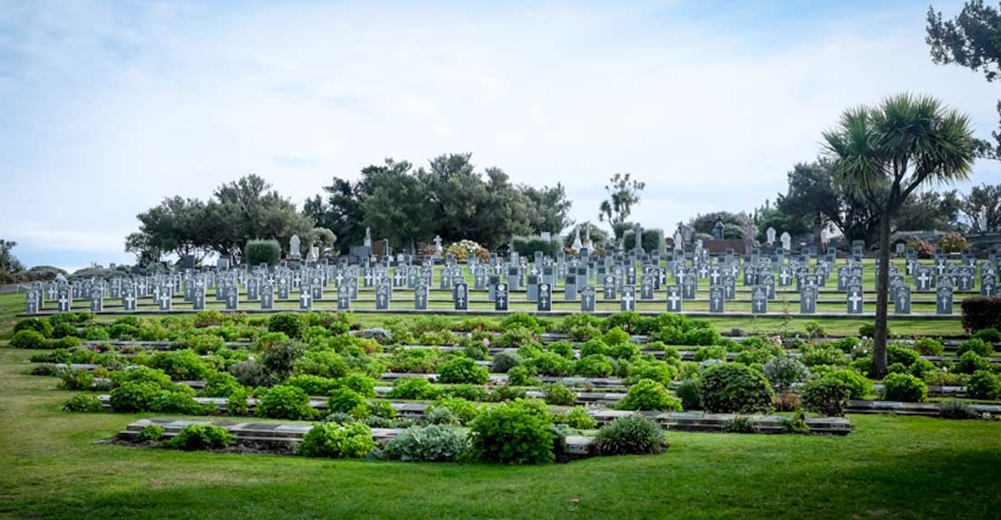
Anderson Bay Cemetery, Dunedin. 118 Commonwealth War Graves can be found within the cemetery, photograph by Becky Masters-Ramsay, courtesy of Manatū Taonga.
before your VISIT a nEW zEALAND wAR MEMORIAL OR GRAVE
Many CWGC war graves and memorials in New Zealand are located in local authority cemeteries, churchyards and urupā (Māori Burial Grounds).
It is important to check in advance that you have permission to visit. Generally, local authority-run cemeteries and churchyards are publicly accessible, however, it is recommended you check ahead of visiting in case specific rules are in place.
If you want to visit an urupā, you will need to gain permission in advance as this is private land. Permission should be requested from the local marae connected to the urupā. If you are permitted to enter, remember this is one of the most tapu (sacred) places to Māori.
It is not permitted to eat, drink or smoke within an urupā boundary: these activities are noa (the antithesis of tapu). People leaving the urupā are expected to wash their hands with water, to reduce the tapu to the safe state of noa.

What do CWGC GRAVES LOOK LIKE IN NEW ZEALAND?
If you’ve visited a New Zealand cemetery before, you may be familiar with the uniform, granite, military services headstones or bronze services plaques found both in services sections and civilian cemeteries.
However, not all Commonwealth war graves are marked the same and the markers come in many styles, materials and shapes.
Outside of services sections these sites are owned, operated and maintained by local authorities, churches or privately. The burial rights of graves are held by individuals, rather than the CWGC. The CWGC honours the choices made by a casualty’s loved ones and often adopts a family headstone or private memorial as their official point of commemoration.
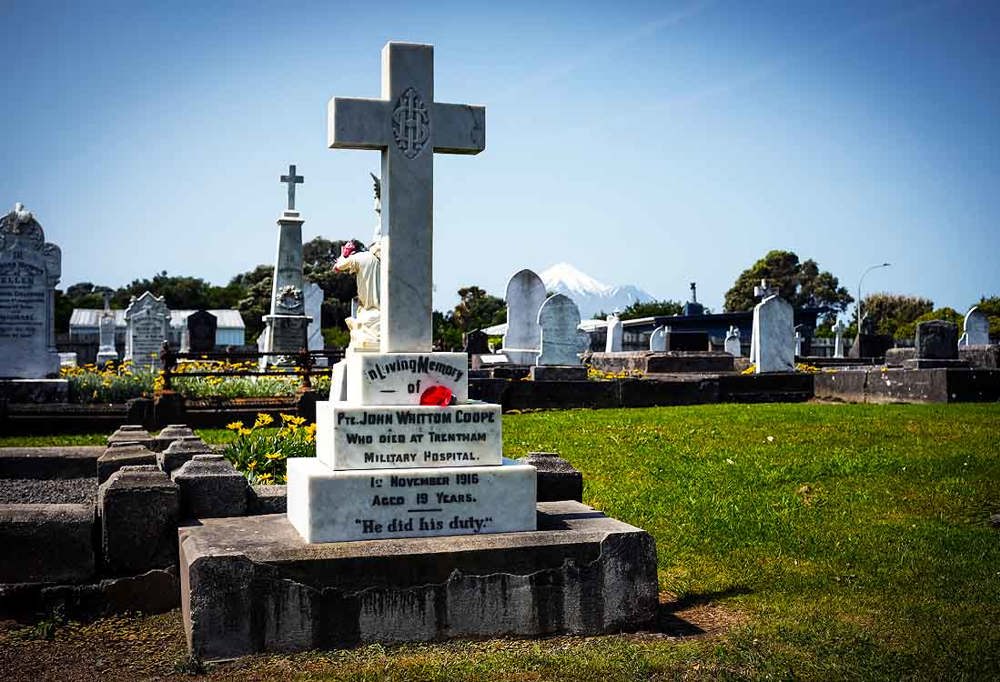
Grave of Private John Whittom Coupe, Opunake Cemetery , photograph by Becky Masters-Ramsay, courtesy of Manatū Taonga.
OTHER SITES OF SIGNIFICANCE IN AOTEAROA NEW ZEALAND
Manatū Taonga is also responsible for caring for national monuments and New Zealand memorials that remember contributions to the country’s development as a nation. As well as caring for CWGC graves, we look after historic graves and monuments in over 81 sites throughout New Zealand.
Find more information about these sites and other places you may wish to explore on the Manatū Taonga website.
While we gather on Anzac Day, Waitangi Day and Remembrance Day to remember the sacrifices made by the men and women of Aotearoa New Zealand, the work of the CWGC and Manatū Taonga continues every day in New Zealand and around the world to commemorate those who gave their lives for our freedom.


